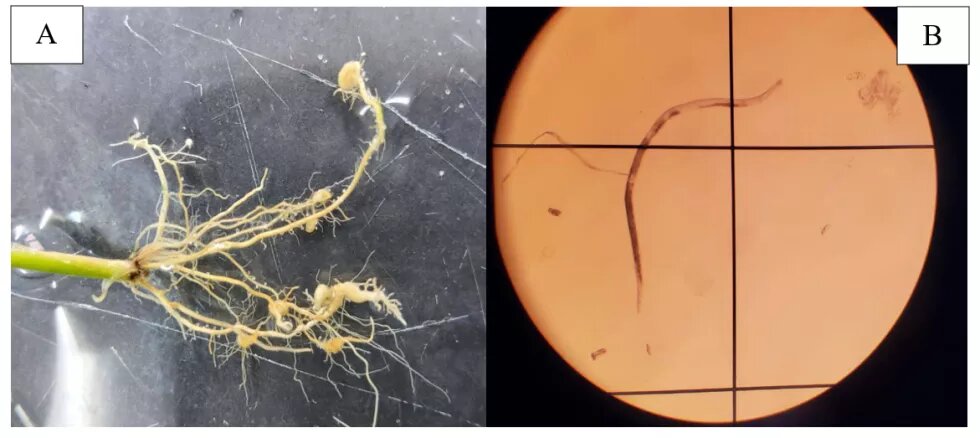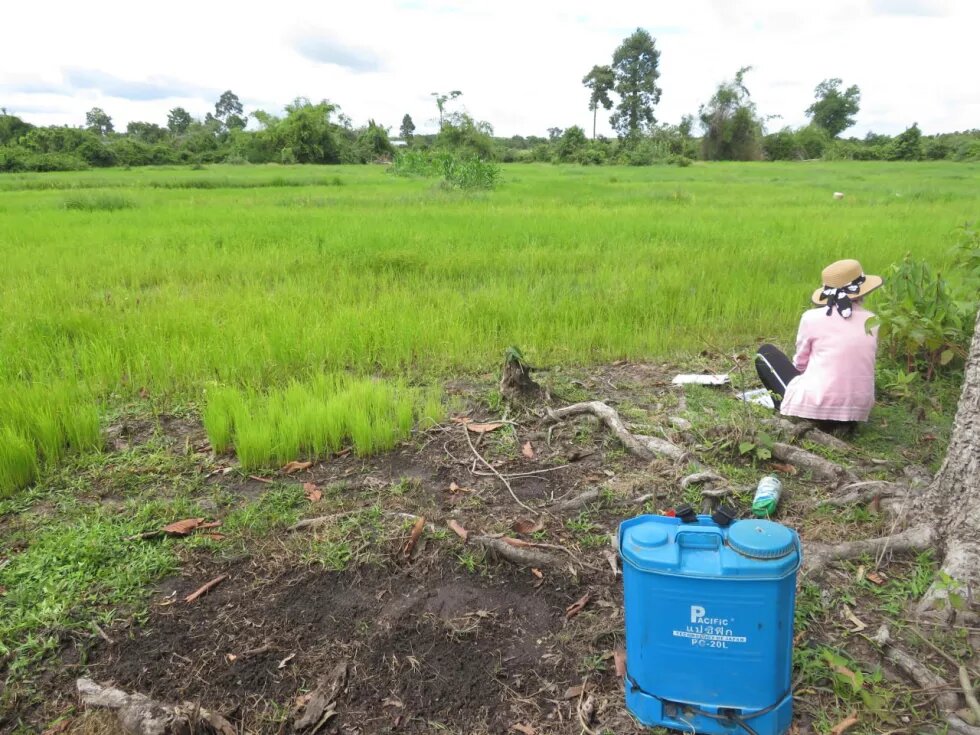
Rice cultivation in the Mekong Region is often afflicted with pests and diseases leading to yield losses and livelihood impacts. This piece by Sourkea explores the impact of rice root-knot nematode (tiny, worm-like creatures found in the soil) which poses a significant threat to rice production in Cambodia.

Root-knot nematodes (RKN) are tiny, worm-like creatures found in soil. They can affect various annual and permanent crops. Rice is one of the most seriously affected, with the root-knot nematodes being particularly adapted to flooded conditions. 1
Root-knot nematodes attack the roots of various trees, shrubs, and herbaceous rice plants. Infested roots become distorted and develop rounded or irregular galls, which result in stunting, fewer tillers, and poor growth and reproduction of rice yields from 20-80%, depending on the population density of the nematode. 2
In southeast Asian countries such as Indonesia, Myanmar, the Philippines, Thailand, and Vietnam, it has generally been observed that there is a yield loss of 15 to 20% in infested fields. 3 Chemical pesticides are highly efficient and practical for controlling root-knot nematodes because they reduce nematode invasion in the plant’s root system or the spread of viruses carried by nematodes to the plant. 4 However, using chemical nematicides raises public concern because of the harmful effects that chemical toxicity has on the environment, soil microorganisms, groundwater, and human health. 5
One-third of the country’s land area is set aside for agricultural output, making Cambodia an agrarian nation. The country’s primary farm output and essential food is rice, which accounts for about 26% of the GDP. 6, 7
More than 80% of farmers in Cambodia grow rice as their primary crop. There are many challenges to rice production in Cambodia. Especially in tropical areas, the root-knot nematode is one of the major rice diseases. However, farmers in Cambodia need to learn more about this type of rice disease that causes the wrong control of rice diseases. Furthermore, the assessment of the effect of the root-knot nematode in Cambodia still needs to be completed. Therefore, root-knot nematode studies should be taken seriously for better management.
A root-knot nematode survey was conducted in 72 rice fields in 17 provinces in Cambodia covering 17 areas including Kampong Chhnaing, Pursat, Banteay Meanchey, Siem Reap, Preah Vihear, Steung Treng, Rattanakiri, Mondulkiri, Kratie, Tbong Khmum, Kampong Thom, Kandal, Kompong, Takeo, Battambang, Kompong Cham, and Prey Veng, of fields infected by the root-knot nematode. Root-knot nematode infections were observed occurring in lowland rainfed agroecosystems by the broadcast sowing method. The direct seeding techniques may also foster the growth of root-knot nematodes in the weeds, which will then infect the rice crop in the following planting season. In addition, most of the rice fields were infected by root-knot nematodes present in the area during non-crop rotation. In this survey, chemical fertilizer and pesticide usage are also considered.
Furthermore, farmers are also utilizing chemical fertilizers, pesticides, and insecticides, which leads to nematode resistance as well as affecting human health and the environment. One survey collected the names and photos of chemical products around rice fields and local markets along with rice pests and diseases in nine different provinces in Cambodia, including Battambang, Kampong Cham, Kratie, Mondol Kiri, Preah Vihear, Pursat, Rattanakiri, Steung Treng, and Tbong Khmum provinces. The survey indicated that 32 different chemical products from 9 provinces in Cambodia with 25 different active compounds were being used. Among the 25 active compounds, none were on the list of highly hazardous, non-hazardous, and 25 moderately dangerous chemicals. Seven out of 28 products were found to be imported from other countries without registration or instructions on how to use them in Khmer. However, we observed that there was no nematicide that farmers were using to control nematodes in rice roots and soil. Consequently, we can assume that our farmers may not yet know about nematodes contaminated with rice roots and dirt.
Furthermore, several strategies to manage root-knot nematodes include physical, biological, and chemical control. However, due to the adverse effects of chemical pesticides, we should consider how to use physical methods like crop cover, crop rotation, and biological means to manage the disease. The government and civil society need to work together to support efforts to raise the awareness of farmers on the effects of chemical pesticides and enhance knowledge about non-chemical methods of management of rice diseases like root-knot nematodes. Last but not least, the government needs to expand studies about the use of bio-pesticides to reduce the use of chemical pesticides in Cambodia including decreasing the importation of pesticide products from abroad.
In summary, the root-knot nematode is a significant problem that poses risks for rice production in Cambodia. Greater awareness needs to be raised among farmers both about this disease and ways to manage their rice crops without the use of harmful chemicals.
__
This article first published by Mekong Commons on 29 May 2023, as part of the output of "Mekong Commons Online Writeshop" supported by Heinrich-Böll-Stiftung Southeast Asia regional office.
Sorn Sourkea is a graduate student from the Institute of Technology of Cambodia majoring in chemical engineering and food science. She specializes in research on integrated pest management focusing on rice cultivation.
The views expressed in this article are not necessarily those of Heinrich Böll Stiftung.
References
- Sacchi S, Torrini G, Marianelli L, et al. Control of Meloidogyne graminicola a Root-Knot Nematode Using Rice Plants as Trap Crops: Preliminary Results. Agriculture. 2021;11(1):37. doi:10.3390/agriculture11010037.
- Khan MR, Ahamad F. Incidence of Root-Knot Nematode ( Meloidogyne graminicola ) and Resulting Crop Losses in Paddy Rice in Northern India. Plant Dis. 2020;104(1):186-193. doi:10.1094/PDIS-12-18-2154-RE.
- Sharma-Poudyal D, Pokharel RR, Shrestha SM, Khatri-Chhetri GB. Population and Effect of Rice Root Knot Nematode in Diseased and Healthy Looking Rice Plants and Their Distribution in Rice Field. J Inst Agric Anim Sci. 2002;23:9-14. doi:10.3126/jiaas.v23i0.469.
- Liu M yan, Peng D liang, Su W, et al. Potassium sulphate induces resistance of rice against the root-knot nematode Meloidogynegraminicola. J Integr Agric. 2022;21(11):3263-3277. doi:10.1016/j.jia.2022.08.002.
- Moens M, Perry RN. Migratory Plant Endoparasitic Nematodes: A Group Rich in Contrasts and Divergence. Annu Rev Phytopathol. 2009;47(1):313-332. doi:10.1146/annurev-phyto-080508-081846.
- https://www.adb.org/projects/documents/rice-situation-cambodia-tacr.
- https://www.adb.org/sites/default/files/linked-documents/44321-014-ld-03.pdf.

